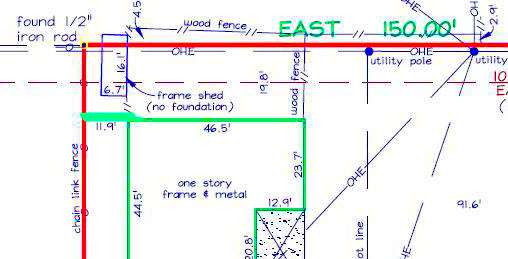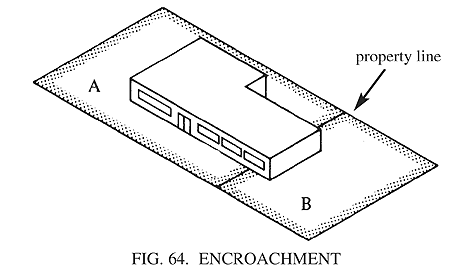Property Line Encroachment Laws: Know Your Rights
Property line encroachment can be a confusing topic for many homeowners. It involves situations where a property owner intrudes on a neighbor’s land, often unintentionally. Understanding the basics of encroachment is essential for protecting your property rights and maintaining good relationships with your neighbors.
Encroachments can lead to disputes that may require legal action, so it’s crucial to be aware of your boundaries. Knowing how to identify and address encroachments can help you avoid costly problems in the future. Let’s explore what property line encroachment is all about.
What Is Property Line Encroachment

Property line encroachment occurs when a structure, tree, or other object extends beyond the legal boundaries of one property and onto another. This can happen due to a lack of awareness, boundary disputes, or simply an oversight. Encroachments can be either physical, such as fences or buildings, or they can involve intangible issues like airspace or easements.
Understanding property lines is vital for homeowners. Property lines are usually defined by surveys and legal documents. If you’re unsure of your property boundaries, it’s wise to get a professional survey done. This can help clarify where your property ends and where your neighbor’s begins, reducing the risk of encroachment issues.
Common Types of Encroachments

There are several common types of encroachments that homeowners may encounter. Here are a few examples:
- Fences: A fence that extends beyond the property line is a frequent source of encroachment disputes.
- Buildings: A garage or shed built too close to or over the property line can lead to legal problems.
- Trees and Shrubs: Overhanging branches or roots that extend into a neighbor’s yard can create tension.
- Driveways: Portions of a driveway that cross over into adjacent property can also be considered encroachments.
Recognizing these common encroachments can help you identify any issues early on. If you suspect an encroachment, it’s best to discuss the matter with your neighbor first. Open communication can often resolve issues before they escalate into formal disputes.
Legal Rights of Property Owners
As a property owner, you have specific rights when it comes to your land. Understanding these rights is crucial, especially if you find yourself dealing with encroachment issues. Generally, property rights include the right to use, enjoy, and sell your property, but they also come with the responsibility to respect your neighbor’s rights.
If you discover that someone is encroaching on your property, you have the right to take action. This can include asking the encroaching party to remove the intrusion, seeking a legal remedy, or potentially reaching an agreement. It’s essential to gather evidence, such as surveys or photographs, to support your case. Here’s a quick overview of your rights:
- Right to Possession: You have the exclusive right to possess and use your property.
- Right to Protect Your Property: You can take necessary steps to protect your property from encroachments.
- Right to Seek Legal Recourse: If needed, you can pursue legal action against encroachers.
- Right to Fair Use: You can use your property as long as it doesn’t harm others or violate zoning laws.
Knowing your rights empowers you to address any issues that arise effectively. If the situation escalates, consulting with a real estate attorney may be your best course of action.
How to Handle Encroachment Issues
When you suspect an encroachment on your property, handling the situation calmly and thoughtfully is essential. Ignoring the issue can lead to more significant disputes, so here are some steps to guide you:
- Verify the Property Lines: Before addressing the issue, confirm your property lines with a professional survey.
- Document the Encroachment: Take photos and gather any relevant documents, such as the survey, to support your claim.
- Communicate with Your Neighbor: Approach your neighbor politely to discuss the encroachment. They may not even be aware of the issue.
- Explore Solutions: Work together to find a mutually agreeable solution, whether it’s relocating a fence or trimming overhanging branches.
By taking these steps, you can often resolve the issue without escalating it further. Remember that open communication is key to maintaining good neighborly relations.
Filing a Dispute Over Encroachment
If discussions with your neighbor don’t resolve the encroachment issue, you may need to consider filing a formal dispute. This process can vary depending on your location, but here are general steps to follow:
- Gather Evidence: Collect all documentation related to the encroachment, including surveys, photos, and any communication with your neighbor.
- Consult an Attorney: Before taking legal action, consult with a real estate attorney who can advise you on your rights and options.
- File a Complaint: Depending on the severity of the encroachment, you may need to file a complaint in small claims court or another appropriate legal venue.
- Attend Mediation: Some jurisdictions require mediation before going to court. This is an opportunity to negotiate a resolution.
- Prepare for Court: If mediation doesn’t work, be ready to present your case in court with all your evidence.
Filing a dispute can be a lengthy and stressful process, but knowing the steps to take can make it easier. Always prioritize finding a resolution that maintains your neighborly relationship when possible.
Preventive Measures for Property Owners
As a property owner, taking preventive measures against encroachment can save you from potential disputes down the road. Being proactive is essential in protecting your property rights and maintaining good relationships with your neighbors. Here are some practical steps you can take to minimize the risk of encroachment:
- Know Your Property Lines: Understanding where your property lines are is the first step in preventing encroachments. Consider getting a professional survey done to clarify your boundaries.
- Mark Your Boundaries: Use physical markers like fences, posts, or landscaping to clearly define your property lines. This helps your neighbors know where your property begins and ends.
- Communicate with Neighbors: Establishing a good relationship with your neighbors can prevent misunderstandings. Discuss any plans for property improvements that may affect them.
- Check Local Zoning Laws: Familiarize yourself with local zoning regulations, which can impact what you can build or modify on your property.
- Keep Records: Maintain records of your property surveys, correspondence with neighbors, and any agreements made regarding property boundaries.
By taking these preventive measures, you can significantly reduce the chances of facing encroachment issues. A little effort upfront can go a long way in maintaining peace and harmony in your neighborhood.
Consulting a Real Estate Attorney
If you encounter an encroachment issue, consulting a real estate attorney can be a wise step. An experienced attorney can guide you through the complexities of property law and help you protect your rights. Here’s how a real estate attorney can assist you:
- Legal Advice: An attorney can provide you with legal advice specific to your situation, helping you understand your rights and options.
- Document Review: They can review any documents, such as property surveys or title deeds, to ensure you have a solid case.
- Negotiation Assistance: If you choose to negotiate with your neighbor, your attorney can help facilitate discussions to reach a fair resolution.
- Litigation Support: If the matter escalates to a lawsuit, your attorney will represent you in court and advocate for your interests.
- Preventive Counsel: An attorney can advise you on preventive measures to avoid future disputes, ensuring your property rights remain protected.
Consulting a real estate attorney can provide you with peace of mind and the legal expertise needed to navigate encroachment issues effectively. Don’t hesitate to seek professional help when needed.
Frequently Asked Questions
When it comes to property line encroachment, many homeowners have common questions. Here are some frequently asked questions to help clarify your concerns:
- What is property line encroachment?
Property line encroachment occurs when a structure or object intrudes on a neighbor’s property line. - How can I know if there is an encroachment?
Getting a professional survey of your property is the best way to determine if any encroachments exist. - What should I do if my neighbor is encroaching on my property?
Start by discussing the issue with your neighbor. If that doesn’t work, consider documenting the encroachment and consulting an attorney. - Can I remove an encroaching structure?
Generally, you have the right to protect your property, but it’s wise to consult an attorney before taking any action. - How can I prevent future encroachments?
Understand your property lines, communicate with neighbors, and use physical markers to define boundaries.
These questions address some common concerns property owners face regarding encroachment. If you have more specific questions, consulting with a real estate attorney can provide tailored guidance for your situation.
Conclusion
Property line encroachment can be a complex issue, but understanding your rights and responsibilities as a property owner can significantly ease the burden. By being proactive—such as knowing your property lines, maintaining good communication with neighbors, and consulting legal professionals when necessary—you can prevent most encroachment disputes before they escalate. If you do find yourself facing an encroachment issue, remember that there are legal avenues available to help protect your property rights. Taking the right steps not only preserves your land but also fosters a sense of community and respect among neighbors.


